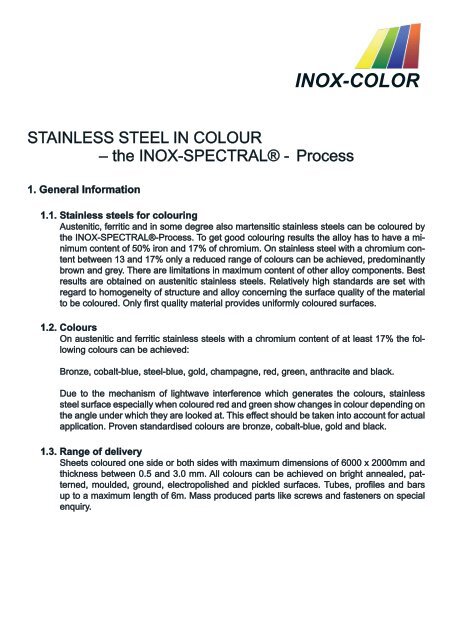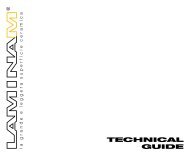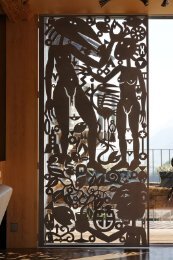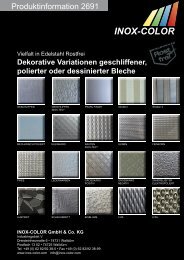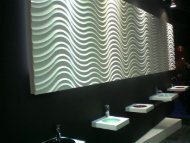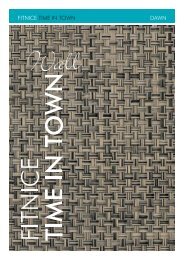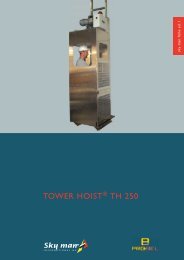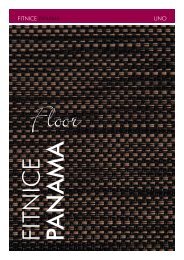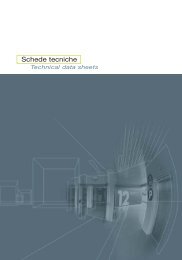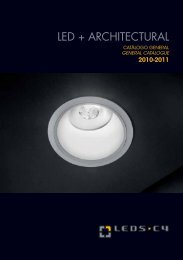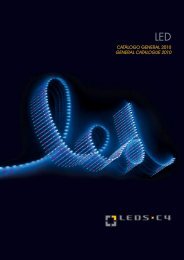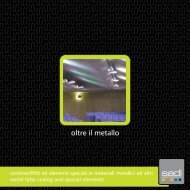Kundeninformation INOX-SPECTRAL-Verfahren-englisch ... - DieMMe
Kundeninformation INOX-SPECTRAL-Verfahren-englisch ... - DieMMe
Kundeninformation INOX-SPECTRAL-Verfahren-englisch ... - DieMMe
Create successful ePaper yourself
Turn your PDF publications into a flip-book with our unique Google optimized e-Paper software.
<strong>INOX</strong>-COLOR<br />
STAINLESS STEEL IN COLOUR<br />
– the <strong>INOX</strong>-<strong>SPECTRAL</strong>® - Process<br />
1. General Information<br />
1.1. Stainless steels for colouring<br />
Austenitic, ferritic and in some degree also martensitic stainless steels can be coloured by<br />
the <strong>INOX</strong>-<strong>SPECTRAL</strong>®-Process. To get good colouring results the alloy has to have a minimum<br />
content of 50% iron and 17% of chromium. On stainless steel with a chromium con-<br />
tent between 13 and 17% only a reduced range of colours can be achieved, predominantly<br />
brown and grey. There are limitations in maximum content of other alloy components. Best<br />
results are obtained on austenitic stainless steels. Relatively high standards are set with<br />
regard to homogeneity of structure and alloy concerning the surface quality of the material<br />
to be coloured. Only fi rst quality material provides uniformly coloured surfaces.<br />
1.2. Colours<br />
On austenitic and ferritic stainless steels with a chromium content of at least 17% the fol-<br />
lowing colours can be achieved:<br />
Bronze, cobalt-blue, steel-blue, gold, champagne, red, green, anthracite and black.<br />
Due to the mechanism of lightwave interference which generates the colours, stainless<br />
steel surface especially when coloured red and green show changes in colour depending on<br />
the angle under which they are looked at. This effect should be taken into account for actual<br />
application. Proven standardised colours are bronze, cobalt-blue, gold and black.<br />
1.3. Range of delivery<br />
Sheets coloured one side or both sides with maximum dimensions of 6000 x 2000mm and<br />
thickness between 0.5 and 3.0 mm. All colours can be achieved on bright annealed, pat-<br />
terned, moulded, ground, electropolished and pickled surfaces. Tubes, profi les and bars<br />
up to a maximum length of 6m. Mass produced parts like screws and fasteners on special<br />
enquiry.
2. Resistance<br />
2.1. Corrosion resistance<br />
The corrosion resistance of the coloured surface basically depends on the corrosion resis-<br />
tance of the stainless steel itself. In view of corrosion resistance the chromium oxide layer<br />
applied by the <strong>INOX</strong>-<strong>SPECTRAL</strong>®-Process chemically strengthens the passive layer of<br />
the stainless steel. Therefore coloured stainless steel normally shows a higher resistance<br />
against corrosion than the uncoloured material. If the stainless steel itself is not durable<br />
against corrosion attack, corrosion will also occur on the coloured surface in a retarded and<br />
reduced manner. Therefore the quality of the material to be coloured has to be selected<br />
according to the corrosive environment to be expected.<br />
2.2. Temperature resistance<br />
The temperature resistance of coloured stainless steel depends mainly on the ac-<br />
tual alloy. Coloured stainless steel will withstand long-time heat-exposure up to 200<br />
degree. Normally short times of higher temperature up to 300 degree are not detri-<br />
mental. If the higher temperature lasts for longer time oxidation will cause a growing<br />
thickness of the oxide layer which produces discoloration. New tests with black co-<br />
loured low chromium-grade stainless steel (type 409) demonstrated a temperature<br />
resistance up to 400 degree and more. Very high temperature caused by welding or<br />
soldering will destroy the coloured surface.<br />
2.3. Resistance of light, weather and ageing<br />
The surface of coloured stainless steel does not contain pigments or colouring substances<br />
which could be bleached or changed by ageing or infl uences of light and weather. Long-<br />
time exhibition to different atmospheric conditions during 25 years have shown no visible<br />
changes on coloured stainless steel. The surface of coloured stainless steel does not crack<br />
or peel and is resistance to ageing.<br />
2.4. Mechanical resistance<br />
The fi lm of chromium which creates the colours is very ductile and homogeneously connec-<br />
ted with the stainless steel. Deformations which do not affect the basic material also will not<br />
impair the coloured surface. Bending, tilting, pressing and even deep-drawing can be done<br />
without affecting the colour and without cracking or peeling of the coloured surface. The resistance<br />
against mechanical wear is limited due to the extremely low thickness of the inter-<br />
ference layer which lies between 0.05 and 0.3μm. Its hardness is somewhat higher than the<br />
hardness of the uncoloured surface. Abrasive wear which affects the uncoloured stainless<br />
steel surface will also destroy the coloured surface. For the application of coloured stainless<br />
steel in areas with high abrasive wear special surfaces have been developed using dessi-<br />
nated or patterned surfaces, the surfaces of which are mechanically ground after colouring.<br />
The abrasive wear then only affects the blank protruding areas, whilst the coloured surface<br />
in the recessed areas is protected against mechanical wear.
3. Processing<br />
3.1. Mechanical Treatment<br />
Provided that the surface is adequately protected (protective fi lm) coloured stainless steel<br />
can generally be mechanically shaped and worked like uncoloured stainless steel.<br />
3.1.1. Machining, Shaping, Cutting<br />
In view of machining like drilling, sawing and milling the same recommendations are<br />
to be obtained as for working the uncoloured steel. Especially when thin sheets are<br />
cut, punched or nibbled, it occurs that partially the coloured surface is drawn over the<br />
blank cutting edge, so that it is less visible than might be expected.<br />
3.1.2. Forming<br />
An appropriate surface protection provide (protective fi lm) coloured stainless steel<br />
can be formed like uncoloured material by bending, canting, chasing, pressing, stam-<br />
ping, rolling and drawing. Normally there is no deterioration of the coloured surface.<br />
Too intense deformation locally may cause changes in gloss of surface.<br />
3.2.Bonding<br />
3.2.1. Mechanical Bonding<br />
Mechanical bonding techniques like bolting, riveting or clamping are applicable to<br />
coloured stainless steel with out restrictions. The recommendations for uncoloured<br />
stainless steel are valid.<br />
3.2.2. Welding<br />
When welding coloured stainless steel generally the recommendations for welding of<br />
stainless steel must be followed. In the area of high temperature at the welding seam<br />
discoloration will take place. Subsequent colouring of these discoloured areas is not<br />
possible. Therefore weldings should be avoided or placed into areas out of the wel-<br />
ding seams as decorative elements. For this purpose they are placed symmetrically<br />
as far as possible and subsequently discoloured by grinding and pickling in a uniform<br />
strip with an accurate line of demarcation (masking). In this way one creates a deco-<br />
rative contrast between the coloured and the uncoloured surface areas. Appropriate<br />
execution provided, on the back side of coloured stainless steel sheets thicker than<br />
0.5mm fasteners can be applied by pinwelding without visible impairment of the co-<br />
loured surface. It is important to reduce welding time and energy input as much as<br />
possible.<br />
3.2.3. Brazing and soldering<br />
For brazing the same restrictions are valid as for welding. Soldering is performed with<br />
special solders which contain at least 40% of tin. Special pastes or phosphoric acid<br />
in a concentration of 50% are used as fl ux. Fluxes containing hydrochloric acid would<br />
tend to affect the surface and cause traces which cannot be removed. Residual fl ux<br />
is to be washed immediately with a solution of soda or alkaline degreasing.
3.2.4. Adhesive Bonding<br />
Compared to uncoloured surface adhesive bonding can be used on coloured stain-<br />
less steel without limitations. Cold as well as warm curing bonding agents can be<br />
used, if the baking temperature does not exceed 200 degree.<br />
3.3. Pickling, Etching, Electropolishing<br />
Chemical and electrochemical processes of surface treatment like pickling, etching and<br />
electropolishing which affect the surface of stainless steel will destroy the coloured surface.<br />
Therefore these processes can be used for application of letters and patterns into coloured<br />
stainless steel. For that purpose the areas in which the coloured surface is to be preserved<br />
are masked by an acid-resistant resist (photoresist, screen-printing or offset printing resist)<br />
and subsequently the areas not so prepared are discoloured.<br />
3.4. Cleaning<br />
The surface of coloured stainless steel is water- and dirtrepellent. It can be cleaned by using<br />
a non-abrasive cleaning agent. Wiping with a clean, soft towel or washing with water con-<br />
taining a commercial detergent is often suffi cient for cleaning. Special advice for cleaning of<br />
coloured stainless steel using industrial cleaners is available.<br />
<strong>INOX</strong>-COLOR GmbH & Co. KG<br />
Industriegebiet V<br />
Dreisteinheumatte 6<br />
74731 Walldürn<br />
Telefon +49 (0) 62 82/92 38-0<br />
Telefax +49 (0) 62 82/92 38-99<br />
info@inox-color.com<br />
www.inox-color.com


